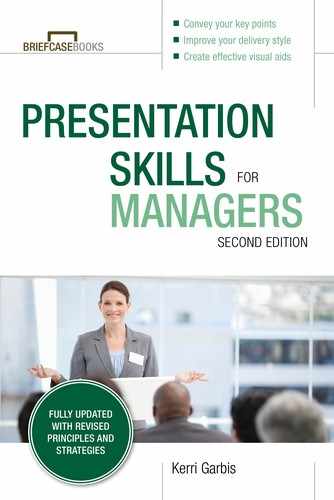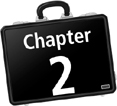
The Essentials
The first step in improving your presentation skills is becoming aware of how you present now. This chapter is designed to help you do that. Some things you do are really good already; some other things might need attention. Finding which skills to feature, and which to fix, is the beginning. Your body language, your eye contact, and your vocal production all contribute to how you’re being perceived and how powerfully you can deliver your message.
The Feet, the Hands, and the Face
Becoming aware of, and eliminating, something you’ve been doing for a long time can be an odd sensation. I encourage you to live with that strangeness for a while, with the promise that you’ll be rewarded with a greater control of the information you’re giving off.
I’ve broken the body down into three areas: the feet, the hands, and the face. By “feet,” I mean your posture in general as well as movement around the stage. By “hands,” I mean gestures, and by “face,” I mean facial expressions and engagement.
Feet
How you move and stand can positively or negatively affect the delivery of your message. Few of us are naturally aware of our habitual resting posture until someone points it out or we see ourselves on camera. While habits like leaning into one hip, clasping your hands behind your back, crossing your ankles, etc., aren’t necessarily offensive, they do give off information and can distract from your message (See Figure 2-1.)
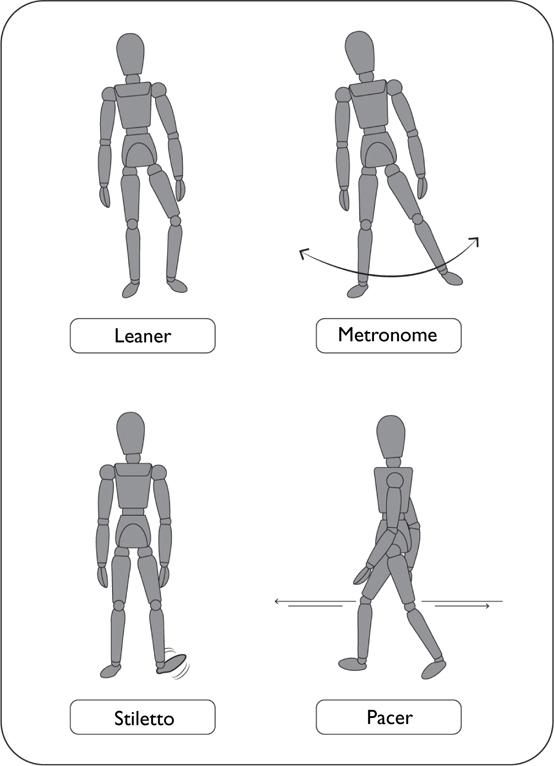
Figure 2-1. Four ineffective habitual stances: The “leaner” spends time sunk into one hip or the other; the “metronome” shifts weight continuously back and forth between the feet; the “stiletto” puts weight on one foot while shaking the foot from the heel of the other; the “pacer” stalks back and forth across the space.
The way to solve any of these ineffective habitual stances is to replace them with another one. I call it Neutral Position.
Neutral Position is a presenter’s balanced, default position that helps ensure that the presenter projects only the information he or she chooses to the audience. It also conveys comfort and confidence. It’s not meant to be a static position but one that you can return to from time to time during your presentation (Figure 2-2).

Figure 2-2. A strong Neutral Position
When I teach this position to people they often say, “This feels weird,” and I agree. It felt weird to me too when I first started practicing it. We’re just not used to being there. Neutral Position is most likely not your “natural position,” but a stance a presenter develops. I encourage you to try it out and let it feel strange for a while until it feels natural.
Remember, this is not a position that you’re stuck in throughout your presentation. It’s simply one of many positions your body will take.
In order to feel comfortable and confident in Neutral Position, it helps to practice it outside of the stress of a presentation. Some good places are waiting in line at the bank, grocery store, airport, or coffee shop. No one will know....
You can also use your strong Neutral Position when seated. Keep your feet flat on the floor, your shoulders back, and your head aligned. Keep your hands and arms above the table, however; no need to leave them at your sides. This is a great place to work from for seated presentations (Figure 2-3).
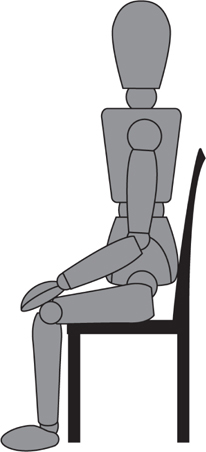
Figure 2-3. Seated Neutral Position
Make a Plan for Stage Movement
Movement around the stage is useful and engaging. However, when done without purpose, it can be pointless and distracting. I’m going to spend a whole chapter discussing effective stage movement, but for now, let me say this: A good rule of thumb is if you don’t have to move, don’t. Sometimes, I see people pacing during their presentations. They stalk the floor from side to side, striding like a general or a caged animal. I believe they think they are generating excitement or conveying a sense of urgency, but to me they seem like they’re trying to find a way to escape. I don’t think it means what they think it means.
If you need to move, plan it. If you want to get out of the way of the screen, good. If you are using spots on the stage to correlate to ideas that you revisit, good. If you are using movement to represent passage of time, etc., good. The rule, again, is this: unless you have a reason to go over there, don’t. Stay where you are. The audience needs to hear what you have to say, and this is the first time they’ve heard it. If you’re wandering or pacing, you’re undercutting your message. Once you’ve synthesized the idea of purposeful, content-related movement, where one supports the other, it’s wonderful. However, doing it in an unplanned or unconscious way is just distracting.
Hands
Much like stage movement, gestures can be an asset or a liability. Open, confident gestures enhance your presentation with clarity, interest, and energy. Closed, indistinct, or ineffective physical habits detract from your content. They also lower credibility, suggest nervousness, or connote lack of interest in your own subject. I’ve seen presenters undercut really interesting content with bad or repetitive gestures.
Figure 2-4 shows some common, ineffective physical habits to recognize and avoid.
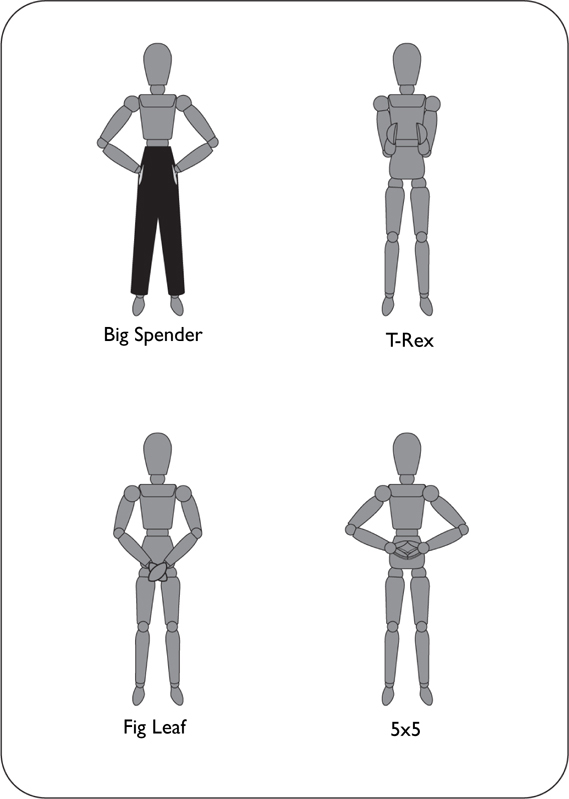
Figure 2-4. Four examples of ineffectual gestures: “Big spenders” hide their hands in their pockets; the “T-rex” keeps elbows connected to the waist, leaving only half an arm to gesture with; “fig leaf” is hands clasped low, in front of you; and the “5x5” is the matchup of the fingertips on each hand, often used to gesture as a unit.
Some general rules to follow are that good gestures are ones that are fully committed, made above the hips, with the elbows away from the body (this avoids “T-rex” arms). But what does it really mean to fully commit to a gesture?
When presenting, the thought behind these gestures, and the desire to make them, won’t change. What will change is the scale. If you’re presenting in a large venue, you want to keep your gestures bigger to balance the size of your stage. Of course, if you’re presenting around a table, use your discretion. While gestures in a small space might be smaller themselves, they shouldn’t be any less distinct.
We all fully commit to gestures every day: when we’re describing something really big or really small; when we celebrate booking a big client; when we bury our head in our hands to cry. We use big, connected, real gestures constantly.
Face
Facial expressions are made up of an incredibly complex interplay of facial muscles.
While some expressions are made consciously, many more are made unconsciously, arising out of what we are feeling in any moment. While we can’t control all of our facial expressions, becoming aware of potential negative habits is essential.
Among the facial expressions we can control, simply smiling is a good place to start. A casual smile is appropriate for nearly any message. Unless you are delivering bad news, why not?
Making Eye Contact Work for You
Along with awareness of our expressions, good eye contact is the most immediate way to foster connection and increase credibility with your audience. Smiling and making eye contact doesn’t come naturally to everyone, however. In the beginning, it may seem awkward or even insincere, but with work it will start to feel more natural, connective, and authentic. The key to comfortable eye contact for all involved lies in knowing how long to hold it.
Regardless of the size of your presentation audience, eye contact comes into play. When in a small group, you’ll want to move your gaze around the room, catching the eyes of everyone at different times. If you’ve got a large audience, you still need to make as much eye contact as you can. Sometimes, due to bright stage lights or especially big crowds, you may only be able to try to focus on one part of a large section at a time. Do your best, but don’t abandon the idea completely.
If you struggle with this, you can begin by practicing a casual smile and relaxed eye contact in all your interactions. If you can learn to use these tools in a nonpressurized situation, it will be that much easier to use them while presenting.
Empowering Your Voice
In terms of vocal production, the beginning of using your voice well is understanding the relationship between breath and vocal support. Whether presenting in a large hall or a boardroom, or even on the phone, good vocal production is vital. This isn’t possible without good breath support. This includes when you’re using a microphone. Any sound designer will tell you that the mic is there to support, not create the voice.
While all of us breathe in a perfectly acceptable manner for remaining alive, some of us don’t breathe effectively for good vocal production. Shallow breathing or a breath that causes tension, around the voice or otherwise is counterproductive. The easiest way to counteract this is to practice what is called the “core breath.”
A good thing to note about volume is that it’s better to be a little too loud than to not be heard. If you are too loud, which is extremely rare, the audience will let you know (either verbally or nonverbally). It’s better to err on the side of greater volume, rather than have parts of your audience miss out on your message.
Listen not only for volume but for variety. Just as we all have habits of posture, we also have habits of pitch. By pitch, I mean the music in your voice, the highs and lows. A varied use of it attracts and holds audience interest and can add to their understanding of your content. The Key Terms give you some vocal patterns to look out for.
The third major area of speech is articulation. Your words lose all value if your audience can’t understand you. Clarity in articulation is essential, from start to finish. Some common pitfalls are the following:
![]() Swallowing Initial Consonants. “This is ...” becomes “’is is,” “That’s how we ...” becomes “’at’s how we,” etc. Often the presenter isn’t using enough volume at the beginning of the sentence, so the audience doesn’t hear any content until the second word.
Swallowing Initial Consonants. “This is ...” becomes “’is is,” “That’s how we ...” becomes “’at’s how we,” etc. Often the presenter isn’t using enough volume at the beginning of the sentence, so the audience doesn’t hear any content until the second word.
![]() Running Words Together. “I’m going to ...” becomes “Ahmanah,” and “Did you ...” becomes “Didja,” and so forth.
Running Words Together. “I’m going to ...” becomes “Ahmanah,” and “Did you ...” becomes “Didja,” and so forth.
![]() Lack of Final Consonants. “Goin’,” “Somethin’,” “Seein’,” etc. The proper use of a final consonant helps make your point very clearly, even if at first it feels overdone.
Lack of Final Consonants. “Goin’,” “Somethin’,” “Seein’,” etc. The proper use of a final consonant helps make your point very clearly, even if at first it feels overdone.
As you’re becoming aware of, and modifying, some of these habits, I can understand if you start to wonder if there is any “you” left in how you speak. Vocal identity is a very personal thing. Changing parts of it, even if those parts are in your way, is really hard. There’s one area that I don’t think you need to change, however. Some people think we need to strive to get rid of our regionalisms, our accents. I don’t agree. All of us have an accent of some kind, whether we think so or not. Particularly strong accents or regionalisms are only a barrier if they keep us from being understood. As long as the words and meaning are clear, the particular, genuine sound of where you come from may be considered part of your personality. Keep your accent. It’s yours. The more confident we feel about how we speak, the more credible we seem.
Avoiding Filler Words
I want to give you a tip that can help you become a better presenter right away: get rid of Verbal Viruses. Verbal Viruses are meaningless filler words or sounds that detract from the delivery of your content. The most common is “um,” but there are many, many more.
You may not even know you’re doing some of them. Start listening for them in other people and see if you’re guilty of any of them yourself. The solution? Replace them with a pause. The pause gives you a moment to think and choose your words. It can also pique the interest of the people listening to you.
These are your presentation essentials. They’re the basic foundations of a good presentation. They take practice and commitment, but nothing I’ve told you here is impossible or mysterious. You can do it. Tackle them a piece at a time, slowly putting them all together until they’re so engrained in your body that they’re second nature.
Manager’s Checklist for Chapter 2
![]() Spend time on your presentation physicality: the feet, hands, and face.
Spend time on your presentation physicality: the feet, hands, and face.
![]() Discover your ineffective stances, as well as your own Neutral Position.
Discover your ineffective stances, as well as your own Neutral Position.
![]() Experiment with bold, supportive gestures while eliminating distracting ones.
Experiment with bold, supportive gestures while eliminating distracting ones.
![]() Ask yourself if your facial expressions are communicating something other than what you intend, and smile (unless you’re delivering bad news!).
Ask yourself if your facial expressions are communicating something other than what you intend, and smile (unless you’re delivering bad news!).
![]() Make eye contact work for you.
Make eye contact work for you.
![]() Get comfortable with making eye contact for three seconds, and practice!
Get comfortable with making eye contact for three seconds, and practice!
![]() Recognize that it’s important in presentations, as well as conversations.
Recognize that it’s important in presentations, as well as conversations.
![]() Empower your voice.
Empower your voice.
![]() Use pitch, articulation, and volume to your advantage.
Use pitch, articulation, and volume to your advantage.
![]() Develop your breath support through core breathing.
Develop your breath support through core breathing.
![]() Avoid filler words
Avoid filler words
![]() Pause instead of uttering a Verbal Virus.
Pause instead of uttering a Verbal Virus.
